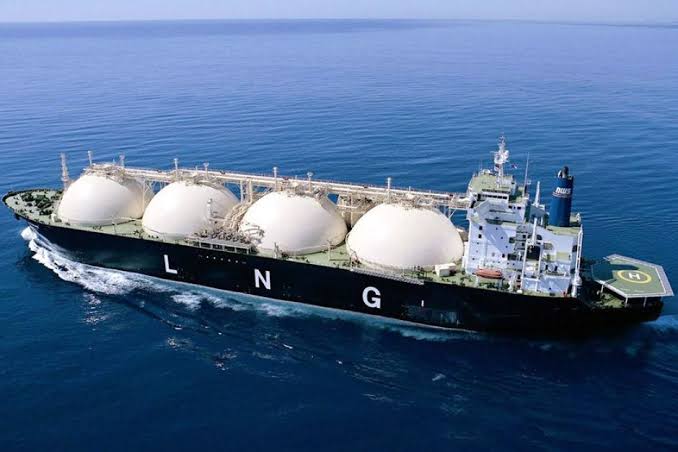Liquefied natural gas (LNG) is natural gas (predominantly methane, CH4, with some mixture of ethane, C2H6) that has been cooled down to liquid form for ease of non-pressurized storage or transport. The volume of natural gas in its liquid state is about 600 times smaller than its volume in its gaseous state in a natural gas pipeline.
This liquefaction process makes it possible to transport natural gas to places natural gas pipelines do not reach and use natural gas as a transportation fuel. Where natural gas pipelines are not feasible or do not exist, liquefying natural gas is a way to move natural gas from producing regions to markets.
LNG export facilities receive natural gas and liquefy the gas for transport on special ocean-going LNG ships or tankers. Most LNG is transported by tankers in large, onboard, cryogenic tanks. LNG is transported in smaller International Organization for Standardization (ISO)-compliant containers that can be placed on ships and trucks.
At import terminals, LNG is offloaded from ships and is stored in cryogenic storage tanks before it is returned to its gaseous state or regasified. After regasification, the natural gas is transported to gas-fired power plants, industrial facilities, and residential and commercial customers.
LNG is the cleanest fossil fuel, but a fossil fuel nonetheless. It has been found that it can no longer credibly be viewed as a bridge fuel between coal and renewables because of methane leaks. These accidental emissions occur during drilling, in the pipelines or during delivery.
The United States imported insignificant amounts of LNG until 1995, and then, it was up and up. LNG imports generally increased until peaking in 2007 at about 771 billion cubic feet (Bcf) and equivalent to 17% of total natural gas imports.
The expansion of natural gas export terminals in the United States — up to 25 projects currently underway — could emit more than 90 million tons of greenhouse gases in a year, according to the Environmental Integrity Project. That figure is roughly equivalent to the carbon pollution produced by 20 coal-fired power plants and does not include emissions that would result from the extraction and end-use of the gas itself.
The rapid upscaling of LNG transport has demanded more pipelines, export facilities, and cryogenic tankers. We are decreasing our energy security and the same time, increasing the climate-harming methane emissions. We are diverting our capital expenditure from green energy to yet more new fossil fuel infrastructure. It is a further delay in the transition to a more sustainable energy source. It has a huge GHG footprint. Its methane leaks hold the power to eliminate any possible benefit of LNG to the climate. Ultimately even with more stringent methane leakage controls, internationally traded LNG is not a very effective emissions reduction strategy. LNG export trade could increase overall energy demand and consumption instead of replacing dirtier fossil fuels in importing countries. Expansion of LNG exports and increased reliance on imported gas will lock in fossil fuel dependence at the expense of already feasible and cost-competitive cleaner energy technologies. The economic costs of the climate change impact from U.S. LNG-related exports—costs that will be borne by the public and not the LNG industry—could exceed $30 billion per year by 2030.
What seemed like an apt replacement for fossil fuels has now proved even worse. It’s time we make smart choices for the world and its climate. If the earth suffers, we will suffer more than it.
‘Only when the last tree has died and the last river been poisoned and the last fish been caught will we realize we cannot eat money.’
-An Indian proverb.
Darshini Shah
This liquefaction process makes it possible to transport natural gas to places natural gas pipelines do not reach and use natural gas as a transportation fuel. Where natural gas pipelines are not feasible or do not exist, liquefying natural gas is a way to move natural gas from producing regions to markets.
LNG export facilities receive natural gas and liquefy the gas for transport on special ocean-going LNG ships or tankers. Most LNG is transported by tankers in large, onboard, cryogenic tanks. LNG is transported in smaller International Organization for Standardization (ISO)-compliant containers that can be placed on ships and trucks.
At import terminals, LNG is offloaded from ships and is stored in cryogenic storage tanks before it is returned to its gaseous state or regasified. After regasification, the natural gas is transported to gas-fired power plants, industrial facilities, and residential and commercial customers.
LNG is the cleanest fossil fuel, but a fossil fuel nonetheless. It has been found that it can no longer credibly be viewed as a bridge fuel between coal and renewables because of methane leaks. These accidental emissions occur during drilling, in the pipelines or during delivery.
The United States imported insignificant amounts of LNG until 1995, and then, it was up and up. LNG imports generally increased until peaking in 2007 at about 771 billion cubic feet (Bcf) and equivalent to 17% of total natural gas imports.
The expansion of natural gas export terminals in the United States — up to 25 projects currently underway — could emit more than 90 million tons of greenhouse gases in a year, according to the Environmental Integrity Project. That figure is roughly equivalent to the carbon pollution produced by 20 coal-fired power plants and does not include emissions that would result from the extraction and end-use of the gas itself.
The rapid upscaling of LNG transport has demanded more pipelines, export facilities, and cryogenic tankers. We are decreasing our energy security and the same time, increasing the climate-harming methane emissions. We are diverting our capital expenditure from green energy to yet more new fossil fuel infrastructure. It is a further delay in the transition to a more sustainable energy source. It has a huge GHG footprint. Its methane leaks hold the power to eliminate any possible benefit of LNG to the climate. Ultimately even with more stringent methane leakage controls, internationally traded LNG is not a very effective emissions reduction strategy. LNG export trade could increase overall energy demand and consumption instead of replacing dirtier fossil fuels in importing countries. Expansion of LNG exports and increased reliance on imported gas will lock in fossil fuel dependence at the expense of already feasible and cost-competitive cleaner energy technologies. The economic costs of the climate change impact from U.S. LNG-related exports—costs that will be borne by the public and not the LNG industry—could exceed $30 billion per year by 2030.
What seemed like an apt replacement for fossil fuels has now proved even worse. It’s time we make smart choices for the world and its climate. If the earth suffers, we will suffer more than it.
‘Only when the last tree has died and the last river been poisoned and the last fish been caught will we realize we cannot eat money.’
-An Indian proverb.
Darshini Shah





